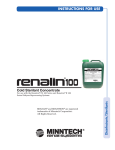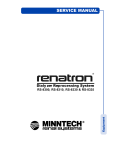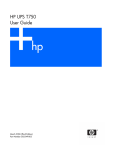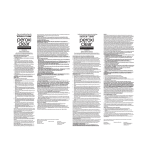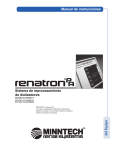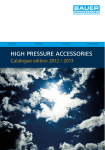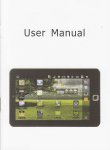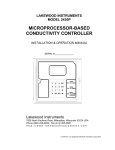Download 50090679.D RENALIN 100 DFU
Transcript
INSTRUCTIONS FOR USE Cold Sterilant Concentrate Disinfectants/Sterilants For use with the Renatron® 100 Series and Renatron® II 100 Series Dialyzer Reprocessing Systems RENALIN® and RENATRON® are registered trademarks of Minntech Corporation. Printed and assembled in the United States. All Rights Reserved. ○ ○ ○ ○ ○ ○ ○ ○ ○ ○ ○ ○ ○ ○ ○ ○ ○ ○ ○ ○ ○ ○ ○ ○ ○ ○ ○ ○ ○ ○ ○ ○ ○ ○ ○ ○ ○ ○ ○ ○ ○ ○ ○ ○ ○ ○ ○ Instructions for Use ○ Instructions for Use ○ ○ ○ ○ ○ ○ ○ ○ ○ ○ ○ ○ ○ ○ ○ ○ ○ ○ ○ ○ ○ ○ ○ ○ ○ ○ ○ ○ ○ ○ ○ ○ ○ ○ ○ ○ ○ ○ ○ ○ ○ ○ ○ ○ ○ ○ IT IS A VIOLATION OF FEDERAL LAW TO USE THIS PRODUCT IN A MANNER INCONSISTENT WITH ITS LABELING. READ THIS MANUAL COMPLETELY PRIOR TO USING RENALIN ® 100 COLD STERILANT. FAILURE TO FOLLOW INSTRUCTIONS IN THIS MANUAL MAY RESULT IN INJURY. RETAIN THIS MANUAL FOR FUTURE REFERENCE. READ THE MACHINE INSTRUCTION MANUAL COMPLETELY PRIOR TO USING RENALIN® 100 COLD STERILANT FOR DIALYZER REPROCESSING WITH THE RENATRON ® 100 SERIES AND RENATRON® II 100 SERIES DIALYZER REPROCESSING SYSTEM. READ THE APPROPRIATE KIDNEY MACHINE INSTRUCTION MANUAL COMPLETELY PRIOR TO USING RENALIN® 100 COLD STERILANT FOR KIDNEY MACHINE DISINFECTION. CAUTION – U.S.A. FEDERAL LAW RESTRICTS THIS PRODUCT TO SALE BY OR ON ORDER OF A PHYSICIAN. WARNING RENALIN® 100 COLD STERILANT IS INTENDED FOR THE PURPOSE OF IN-VITRO CLEANING AND STERILIZING OF HOLLOW FIBER DIALYZERS WITH THE RENATRON® 100 SERIES AND RENATRON® II 100 SERIES DIALYZER REPROCESSING SYSTEM WHICH IS LABELED FOR USE WITH RENALIN® 100. ANY SUBSEQUENT CLINICAL APPLICATION OR USE OF A HOLLOW FIBER DIALYZER THAT HAS BEEN REPROCESSED USING RENALIN® 100 IS THE SOLE RESPONSIBILITY OF THE ATTENDING PHYSICIAN. WARNING A HOLLOW FIBER DIALYZER THAT IS REPROCESSED AND STERILIZED WITH RENALIN ® 100 COLD STERILANT BY THE RENATRON® 100 SERIES AND RENATRON® II 100 SERIES DIALYZER REPROCESSING SYSTEM IS FILLED WITH A PROPORTIONED RENALIN® 100 SOLUTION (HYDROGEN PEROXIDE AND PEROXYACETIC ACID). THE PROPORTIONED RENALIN® 100 SOLUTION MUST BE ADEQUATELY AND THOROUGHLY RINSED OUT OF THE DIALYZER PRIOR TO CLINICAL USE. CAUTION – WHEN USING RENALIN® 100 COLD STERILANT TO DISINFECT KIDNEY MACHINES FOLLOW KIDNEY MACHINE MANUFACTURER’S DIRECTIONS. ○ ○ ○ ○ ○ ○ ○ ○ ○ ○ ○ ○ ○ ○ ○ ○ ○ ○ ○ ○ ○ ○ ○ ○ ○ ○ ○ ○ ○ ○ ○ ○ -1- ○ ○ ○ ○ ○ ○ ○ ○ ○ ○ ○ ○ ○ ○ ○ Instructions for Use Warranty and Limitation of Damages MINNTECH WARRANTS TO CUSTOMER THAT MINNTECH POSSESSES GOOD AND MARKETABLE TITLE TO THE PRODUCT SOLD TO CUSTOMER AND THAT THE PRODUCTS ARE FREE FROM DEFECTS IN MATERIAL AND WORKMANSHIP AT THE TIME OF SHIPMENT AND UNDER NORMAL USE FOR THE PERIOD OF TIME SPECIFIED ON THE PRODUCT'S LABELING; AND (ii) ARE IN COMPLIANCE WITH THE SPECIFICATIONS FOR THE PRODUCTS. THE LIABILITY OF MINNTECH UNDER THIS LIMITED WARRANTY DOES NOT EXTEND TO ANY ABUSE OR MISUSE OF THE PRODUCTS, ANY USE THAT IS CONTRAINDICATED OR ANY USE THAT IS NOT IN ACCORDANCE WITH THE PRODUCT‘S LABELING, WHICH SHALL VOID THIS WARRANTY. IF THE PRODUCT DOES NOT MEET THIS LIMITED WARRANTY, MINNTECH'S SOLE OBLIGATION SHALL BE TO REPLACE THE PRODUCT, AND THIS SHALL BE CUSTOMER‘S EXCLUSIVE REMEDY. UNDER NO CIRCUMSTANCES WILL MINNTECH BE LIABLE FOR ANY DIRECT OR INDIRECT, INCIDENTAL OR CONSEQUENTIAL LOSS, DAMAGE OR EXPENSE OF ANY KIND (INCLUDING WITHOUT LIMITATION, LOSS OF PROFITS, OR ECONOMIC LOSS) WHETHER SUCH CLAIM IS BASED ON WARRANTY, CONTRACT, TORT OR OTHERWISE. THIS LIMITED WARRANTY IS IN LIEU OF ALL OTHER WARRANTIES, WHETHER EXPRESS OR IMPLIED. (INCLUDING, WITHOUT LIMITATION, ANY WARRANTY FOR SUITABILITY, FITNESS FOR A PARTICULAR PURPOSE OR ABSENCE OF HIDDEN DEFECTS). Contents I. INDICATIONS ........................................................................................ 3 II. CONTRAINDICATIONS ........................................................................ 3 III. WARNINGS AND PRECAUTIONS ........................................................ 3 IV. STATEMENT OF PRACTICAL TREATMENT ...................................... 5 V. DESCRIPTION ........................................................................................ 6 VI. SPECIFICATIONS .................................................................................. 8 VII. DILUTION AND INITIAL HANDING INSTRUCTIONS ....................... 8 VIII. HANDLING AND STORAGE OF REPROCESSED DIALYZERS ......... 10 IX. RENALIN® 100 PRESENCE TEST PRIOR TO DIALYZER RINSE ...... 11 X. RECOMMENDED DIALYZER RINSE PROCEDURE ........................... 13 XI. RENALIN® 100 RESIDUAL TEST FOLLOWING DIALYZER RINSE . 16 XII. RENALIN® 100 SPILL PROCEDURE ................................................... 17 XIII. PART NUMBER REFERENCE TABLE ................................................. 18 ○ Instructions for Use ○ ○ ○ ○ ○ ○ ○ ○ ○ ○ ○ ○ ○ ○ ○ ○ -2- ○ ○ ○ ○ ○ ○ ○ ○ ○ ○ ○ ○ ○ ○ ○ ○ ○ ○ ○ ○ ○ ○ ○ ○ ○ ○ ○ ○ ○ ○ Renalin® 100 Cold Sterilant is indicated for the in vitro cleaning and sterilizing of hollow fiber dialyzers with the Renatron® 100 Series and Renatron® II 100 Series Dialyzer Reprocessing System labeled for use with Renalin®100. Renalin® 100 Cold Sterilant also may be used for disinfecting dialysis equipment (e.g. kidney machines) and supplies (e.g. port caps). Indications Renalin® 100 Cold Sterilant is not designed, sold, or intended for use except as indicated. Contraindications Patients with known hypersensitivity to hydrogen peroxide and/or peroxyacetic acid should not be treated using dialyzers reprocessed with Renalin® 100 Cold Sterilant. Warnings and Precautions ALL PERSONNEL USING RENALIN® 100 COLD STERILANT SHOULD BE FAMILIAR WITH THE INFORMATION CONTAINED IN THIS MANUAL. WARNING – IT IS THE RESPONSIBILITY OF THE PRESCRIBING PHYSICIAN TO ENSURE THAT THE USERS OF RENALIN® 100 COLD STERILANT ARE PROPERLY TRAINED AND TECHNICALLY COMPETENT. DANGER – KEEP OUT OF REACH OF CHILDREN. WARNING – CORROSIVE - CAN CAUSE EYE DAMAGE AND SKIN IRRITATION. DO NOT GET IN EYES, ON SKIN OR ON CLOTHING. USE UNIVERSAL PRECAUTIONS. WEAR EYE PROTECTION, RUBBER GLOVES, AND PROTECTIVE CLOTHING WHEN HANDLING RENALIN® 100 COLD STERILANT. WASH THOROUGHLY AFTER HANDLING. IN CASE OF EYE OR SKIN CONTACT, IMMEDIATELY FLUSH WITH LARGE AMOUNTS OF WATER. WARNING – HARMFUL IF SWALLOWED. IF SWALLOWED, DRINK WATER IMMEDIATELY TO DILUTE. DO NOT ATTEMPT TO INDUCE VOMITING. CALL PHYSICIAN IMMEDIATELY. NOTE TO PHYSICIAN – PROBABLE MUCOSAL DAMAGE MAY CONTRAINDICATE GASTRIC LAVAGE. WARNING – DO NOT ALLOW RENALIN® 100 COLD STERILANT TO MIX WITH ALKALINE SUBSTANCES SUCH AS BLEACH (SODIUM HYPOCHLORITE). WARNING – OXIDIZER - AVOID CONTACT WITH COMBUSTIBLE MATERIALS. ○ ○ ○ ○ ○ ○ ○ ○ ○ ○ ○ ○ ○ ○ ○ ○ ○ ○ ○ ○ ○ ○ ○ ○ ○ ○ ○ ○ ○ ○ ○ ○ -3- ○ ○ ○ ○ ○ ○ ○ ○ ○ ○ ○ ○ ○ ○ ○ Instructions for Use CAUTION • RENALIN ® 100 COLD STERILANT WILL UNDERGO RAPID DECOMPOSITION IF ALLOWED TO CONTACT METAL, DUST, ORGANIC MATERIALS OR IF IT IS DILUTED WITH WATER FAILING TO MEET ANSI/AAMI STANDARDS. • STORE RENALIN® 100 COLD STERILANT UPRIGHT IN THE ORIGINAL SHIPPING CARTON. STORE RENALIN® 100 COLD STERILANT IN ORIGINAL UNOPENED CONTAINER. NEVER TAMPER WITH VENT CAP. • DO NOT STORE RENALIN® 100 COLD STERILANT IN DIRECT SUNLIGHT. • MAINTAIN STORAGE TEMPERATURE BETWEEN 32˚F-75˚F (0˚C24˚C). • THE EXPIRATION DATE OF RENALIN® 100 IS INDICATED ON THE CONTAINER LABEL. THE EXPIRATION OF 1% RENALIN® 100 SOLUTION IS 24 HOURS FROM THE TIME OF DILUTION. FOR ANY OTHER APPLICATIONS THAT MAY REQUIRE DILUTION OF RENALIN® 100 CONTACT YOUR MINNTECH REPRESENTATIVE FOR ADDITIONAL INFORMATION. • USE AAMI QUALITY WATER FOR DILUTION OF RENALIN® 100 COLD STERILANT. • ALWAYS USE RENALIN® 100 UPTAKE TUBE/CHECK VALVE. • USE CARE WHEN DISCONNECTING THE DIALYZER FROM THE RENATRON® 100 SYSTEM TO AVOID BEING SPRAYED WITH RENALIN® 100 SOLUTION. • USE ONLY THOSE CAPS SPECIFIED FOR USE WITH RENALIN® 100 AND/OR RENALIN ® 100 COLD STERILANT TO CLOSE THE DIALYSATE PORTS AND BLOOD PORTS. • USE CARE WHEN REMOVING PORT CAPS FROM REPROCESSED DIALYZERS AFTER STORAGE TO AVOID BEING SPRAYED WITH PROPORTIONAL RENALIN® 100 SOLUTION. • AFTER STORAGE AND BEFORE RINSING, DIALYZERS MUST BE FILLED WITH PROPORTIONED RENALIN® 100 SOLUTION. THE SIZE OF THE AIR BUBBLE IN THE HEADER SHOULD BE NO LARGER THAN ONE-THIRD (1/3) THE TOTAL CROSS-SECTIONAL AREA OF THE HEADER. • AFTER STORAGE AND BEFORE THE DIALYZER IS RINSED AND CLINICALLY USED, A RENALIN® 100 PRESENCE PERASSAY® 500 TEST SHOULD BE PERFORMED. • AFTER RINSING THE DIALYZER AND IMMEDIATELY PRIOR TO CLINICAL USE, A RENALIN® 100 RESIDUAL TEST SHOULD BE PERFORMED. ○ Instructions for Use ○ ○ ○ ○ ○ ○ ○ ○ ○ ○ ○ ○ ○ ○ ○ ○ -4- ○ ○ ○ ○ ○ ○ ○ ○ ○ ○ ○ ○ ○ ○ ○ ○ ○ ○ ○ ○ ○ ○ ○ ○ ○ ○ ○ ○ ○ ○ • RINSE KIDNEY MACHINE ACCORDING TO MANUFACTURER’S INSTRUCTIONS FOLLOWING DISINFECTION STEPS. • USE AAMI QUALITY WATER FOR RINSING KIDNEY MACHINES AFTER DISINFECTING WITH RENALIN ® 100 SOLUTION. RECONTAMINATION OF MACHINES IS POSSIBLE IF RINSE WATER DOES NOT MEET AAMI QUALITY STANDARDS. • WHEN USED WITH KIDNEY MACHINES, DO NOT HEAT RENALIN® 100 COLD STERILANT ABOVE 75˚F (24˚C). • WHEN USED WITH KIDNEY MACHINES, CHECK WITH MACHINE MANUFACTURER TO VERIFY COMPATIBILITY OF MATERIALS. • IF SPILLED, FLUSH AWAY WITH LARGE QUANTITIES OF WATER. SEE RENALIN® 100 SPILL PROCEDURE IN THIS MANUAL. IN CASE OF CONTACT WITH SKIN OR EYES, IMMEDIATELY FLUSH WITH LARGE AMOUNTS OF WATER FOR AT LEAST FIFTEEN (15) MINUTES. FOR EXPOSURE TO EYES, REMOVE CONTACT LENSES AND CONTINUE TO FLUSH EYES THOROUGHLY WITH WATER FOR AT LEAST FIFTEEN (15) MINUTES. PROMPT MEDICAL ATTENTION IS NECESSARY. Statement of Practical Treatment IF SWALLOWED, DRINK WATER IMMEDIATELY TO DILUTE. DO NOT ATTEMPT TO INDUCE VOMITING. CALL PHYSICIAN IMMEDIATELY. NOTE TO PHYSICIAN - PROBABLE MUCOSAL DAMAGE MAY CONTRAINDICATE GASTRIC LAVAGE. FOR CHEMICAL EMERGENCY, SPILL, LEAK, FIRE, EXPOSURE, OR ACCIDENT CALL: CHEMTREC 800-424-9300 IN DISTRICT OF COLUMBIA OR OUTSIDE CONTINENTAL U.S.A. CALL (703) 527-3887. ○ ○ ○ ○ ○ ○ ○ ○ ○ ○ ○ ○ ○ ○ ○ ○ ○ ○ ○ ○ ○ ○ ○ ○ ○ ○ ○ ○ ○ ○ ○ ○ -5- ○ ○ ○ ○ ○ ○ ○ ○ ○ ○ ○ ○ ○ ○ ○ Instructions for Use General Product Application Description Renalin® 100 Cold Sterilant is intended for dialyzer reprocessing with models RS8300 Renatron® 100 Series Dialyzer Reprocessing System (hereafter refered to as Renatron® 100) and RS8330 Renatron® II 100 Series Dialyzer Reprocessing System (hereafter refered to as Renatron® 100) labeled for use with Renalin® 100. Renalin® 100 Cold Sterilant maintains stability for one year when stored according to label directions. Renalin® 100 Cold Sterilant may be used for manual dialyzer reprocessing. Facilities practicing manual dialyzer reprocessing must independently validate their reprocessing protocols to establish safety and effectiveness according to ANSI/AAMI guidelines. Contact Renal Systems for additional information. Once properly diluted, the active ingredients will begin to decay. Renalin® 100 Cold Sterilant offers the following advantages compared to traditional reprocessing chemicals: 1. Renalin® 100 is a single solution which replaces formaldehyde, hydrogen peroxide, and/or bleach when used for dialyzer reprocessing. 2. Post-storage, pre-rinse Renalin® 100 concentration tests are conducted quickly and easily. 3. Post-rinse, pre-treatment Renalin® 100 residual tests are conducted quickly and easily. 4. Renalin® 100 byproducts degrade quickly and do not harm the environment. These byproducts are oxygen, water, and an acetic acid mixture. All by-products are natural and, when properly diluted, safe to flush into a sanitary sewer system. Nomenclature For the purpose of clarity, the following nomenclature will be used throughout this manual. 1. AAMI QUALITY WATER - is water which meets or exceeds the following requirements: a. AAMI/ANSI Standard for Hemodialysis Systems1; and b. Pre-filtration through a 1.0 micron or smaller filter. 2. RENALIN® 100 COLD STERILANT - is the concentrated solution manufactured by Renal Systems for use with Dialyzer Reprocessing Systems, or for other uses in environments administering dialysis care. 3. PROPORTIONED RENALIN® 100 SOLUTION - is the final solution proportioned by the Renatron® 100 reprocessing system used in cleaning and sterilizing the reprocessed dialyzer. 4. 1% RENALIN® 100 SOLUTION - is a solution by volume resulting from the user’s addition of AAMI quality water (also known as a 100x dilution.) ○ Instructions for Use ○ ○ ○ ○ ○ ○ ○ ○ ○ ○ ○ ○ ○ ○ ○ ○ -6- ○ ○ ○ ○ ○ ○ ○ ○ ○ ○ ○ ○ ○ ○ ○ ○ ○ ○ ○ ○ ○ ○ ○ ○ ○ ○ ○ ○ ○ ○ Renalin® 100 Cold Sterilant consists of: 1. A stabilized mixture of hydrogen peroxide, peroxyacetic acid, and acetic acid. 2. The mixture is supplied with: a. 0.79 U.S. liquid gallons (3 liters) in a 1 U.S. liquid gallon (3.78 liter) container. 3. Package contains four (4) containers. 4. Each container has a vented cap to prevent excessive pressure build-up during shipping and storage. CAUTION – NEVER CHANGE VENT CAPS OR TAMPER WITH ANY PART OF THE VENT CAP. Perassay™ 500 Peracetic Acid Test Strips (P/N 78378-000) consists of: 1. Peracetic acid test strips. 2. Package insert. Renalin® Indicator Test Kit (P/N 78199-000) consists of: 1. Relative indicator test strips. 2. Graduated dilution vial. Renalin® Residual Test Strips (P/N 78198-000) consist of: 1. Residual test strips. 2. Package insert. 3. Quantitative color chart for interpreting test results. Renal Systems Test Strip Reference Chart Long Term Storage Conditions Storage Conditions Test Stip P/N Use Unopened Opened 78378-000 Concentration test following reprocessing 41°Fdry - 104°F Cool place. 39° F - 104° F 5°C - 40°C 4° C - 40° C Renalin® Indicator 78199-000 Concentration test following reprocessing 41°Fdry - 104°F Cool place. 39° F - 104° F 5°C - 40°C 4° C - 40° C Room temperature. Do not refrigerate. Tightly reclose vial when not in use. Renalin® Residual 78198-000 Residual test following dialyzer rinsing Cool 41°F dry - 86°F place. Cool dry place. Refrigerate. 39°F - 104°F 41° 59° F 5°CF -- 30°C 4°C - 40°C 5° C - 15° C Roomdry temperature. Cool place. Do not not refrigerate. refrigerate. Do Tightly reclose reclosevial vial Tightly when not not in in use. use. when Perassay® 500 Room temperature. Do not refrigerate. Tightly reclose vial when not in use. NOTE – RENALIN® RESIDUAL TEST STRIPS SHOULD BE STORED AT ROOM TEMPERATURE. KEEP CONTAINER TIGHTLY CAPPED WHEN NOT IN USE. CHECK EXPIRATION DATE ON CONTAINER PRIOR TO USE. ○ ○ ○ ○ ○ ○ ○ ○ ○ ○ ○ ○ ○ ○ ○ ○ ○ ○ ○ ○ ○ ○ ○ ○ ○ ○ ○ ○ ○ ○ ○ ○ -7- ○ ○ ○ ○ ○ ○ ○ ○ ○ ○ ○ ○ ○ ○ ○ Instructions for Use Dialyzer Testing Testing of reprocessed dialyzers performs two functions: 1. Renalin® 100 presence test - verifies the dialyzer is filled with an effective concentration of proportioned Renalin® 100 solution. 2. Renalin® 100 residual test - verifies the proportioned Renalin® 100 solution has been properly removed (rinsed) from the dialyzer prior to clinical use (patient connection). Kidney Machines To disinfect kidney machines using Renalin® 100 Cold Sterilant, follow the kidney machine manufacturer’s directions for use. Specifications Active Ingredients: Hydrogen peroxide and Peroxyacetic acid Packaging Item Weight Height Width Depth Individual shipping carton (4 x 1 U.S. Gallon Container) Approx. 30 lbs. 13 - 1/4" 12 - 3/4" 12 - 3/4" Dilution Requirements Manual Dilution and Initial Handling Instructions 1. Water used for manual dilution must meet or exceed the ANSI/ AAMI standards for Hemodialysis Systems2 and ANSI/AAMI Reuse of Hemodialyzers.3 2. Water used for manual dilution must be pre-filtered through a 1.0 micron or smaller filter. 3. Water used for manual dilution must be at a temperature between 59˚F- 75˚F (15˚C-24˚C). Environmental Limits 1. Maintain storage temperature of Renalin® 100 Cold Sterilant and proportioned Renalin® 100 solution between 32˚F-75˚F (0˚C-24˚C) 2. DO NOT FREEZE. 3. DO NOT STORE IN DIRECT SUNLIGHT. Shelf Life 1. Renalin® 100 Cold Sterilant is stable for one year when stored according to label directions. An expiration date is assigned at the time of manufacture. 2. Following dilution, Renalin® 100 exhibits a gradual loss of potency at a rate such that 50% of the active ingredients remain after a seven day period. This deterioration has been considered while calculating the amount of Renalin® 100 to be used with the Renatron® 100 Dialyzer Reprocessing Systems. ○ Instructions for Use ○ ○ ○ ○ ○ ○ ○ ○ ○ ○ ○ ○ ○ ○ ○ ○ -8- ○ ○ ○ ○ ○ ○ ○ ○ ○ ○ ○ ○ ○ ○ ○ ○ ○ ○ ○ ○ ○ ○ ○ ○ ○ ○ ○ ○ ○ ○ 3. When diluting Renalin® 100 Cold Sterilant to a 1% solution (e.g. port cap disinfection) fresh Renalin® 100 Cold Sterilant should be used each time. Do not allow 1% Renalin® 100 solution to sit for longer than 24 hours. WARNING – DO NOT GET IN EYES, ON SKIN OR ON CLOTHING. USE UNIVERSAL PRECAUTIONS. WEAR EYE PROTECTION, RUBBER GLOVES, AND PROTECTIVE CLOTHING WHEN HANDLING RENALIN® 100 COLD STERILANT. WASH THOROUGHLY AFTER HANDLING. CAUTION – PRIOR TO USE IN THE RENATRON®100, RENALIN® 100 COLD STERILANT MUST NOT BE DILUTED. CAUTION – ALWAYS STORE RENALIN® 100 COLD STERILANT UPRIGHT AND OUT OF DIRECT SUNLIGHT. EXPOSURE TO SUNLIGHT DAMAGES THE CLEANING AND DISINFECTING QUALITIES OF RENALIN® 100 COLD STERILANT. NOTE – STORING RENALIN® 100 COLD STERILANT IN ITS ORIGINAL SHIPPING CARTON PREVENTS EXPOSURES TO DIRECT SUNLIGHT. NOTE – THE RENALIN® 100 COLD STERILANT CONTAINER IS TRANSLUCENT AND IS PACKAGED IN A SHIPPING CARTON. THE CONTAINER IS TRANSLUCENT TO ALLOW THE USER TO VIEW THE LEVEL OF SOLUTION. Dilution for 1% Renalin® 100 Solution NOTE – TO ASSURE EFFICACY, MAKE FRESH 1% RENALIN® 100 SOLUTION DAILY. DO NOT ALLOW 1% RENALIN® 100 SOLUTION TO SIT OVERNIGHT FOR USE THE FOLLOWING DAY. 1. To make 1% Renalin® 100 Solution from Renalin® 100 Cold Sterilant®: a. Dilute one part Renalin® 100 Cold Sterilant® with 99 parts AAMI quality water. To make the volume of 1% Renalin® 100 solution (by volume) shown in column three, dilute the volume of Renalin® 100 Cold Sterilant (by volume) shown in column one with the volume of AAMI quality water shown in column two. ○ ○ ○ ○ ○ ○ ○ ○ ○ ○ ○ ○ ○ ○ Renalin® 100 Cold Sterilant AAMI Quality Water ○ 1% Renalin® 100 Solution 5 mL 495 mL 500 mL 10 mL 990 mL 1000 mL 15 mL 1485 mL 1500 mL 20 mL 1980 mL 2000 mL ○ ○ ○ ○ ○ ○ ○ ○ ○ ○ ○ ○ ○ ○ ○ ○ ○ -9- ○ ○ ○ ○ ○ ○ ○ ○ ○ ○ ○ ○ ○ ○ ○ Instructions for Use Handling and Storage of Reprocessed Dialyzers WARNING – REPROCESSED DIALYZERS SHOULD NOT BE CLINICALLY USED UNTIL A MINIMUM STORAGE TIME OF ELEVEN (11) HOURS HAS ELAPSED SINCE THE FINAL REPROCESSING CYCLE. WARNING – AFTER THE DIALYZER HAS BEEN REPROCESSED AND FILLED WITH RENALIN® 100 COLD STERILANT, ANY REMAINING BLOOD PRODUCTS IN THE DIALYZER WILL REACT WITH THE RENALIN® 100 AND CAUSE PRESSURE BUILD-UP. USE CARE AT ALL TIMES TO AVOID BEING SPRAYED WITH THE RENALIN® 100 SOLUTION. CAUTION – IF EXCESSIVE FOAMING AT BLOOD LINE/DIALYZER CONNECTOR IS APPARENT UPON COMPLETION OF REPROCESSING, THE OPERATOR SHOULD REPROCESS THE DIALYZER AGAIN. THIS ACTION WILL REDUCE THE POSSIBILITY OF A LARGE DIALYZER PRESSURE BUILDUP IN STORAGE AND MAY IMPROVE VOLUME MEASUREMENT. 1. Disconnect the dialyzer from the Renatron® 100 reprocessing system. Use caution when disconnecting the dialyzer to avoid being sprayed with proportioned Renalin® 100 solution. 2. Do not proceed with reuse of dialyzers where a volume of less than 80% of original priming volume is obtained. High residual amounts of blood products (organic load), indicated by a low priming volume, may reduce Renalin® 100 concentrations below an effective level. 3. Place disinfected blood port caps and dialysate port caps on the dialyzer. Refer to the Renatron® 100 Instruction Manual for further details. CAUTION – DIALYZERS REPROCESSED WITH PROPORTIONED RENALIN® 100 SOLUTION MAY UNDERGO AN INTERNAL PRESSURE BUILD-UP DURING STORAGE. THEREFORE, ONLY USE RENAL SYSTEMS ® DIALYSATE PORT CAPS. A VENTABLE DIALYZER DIALYSATE PORT CAP (P/N 78208-000) ALLOWS PERSONNEL TO VENT PRESSURE BUILD-UP IN DIALYZERS PRIOR TO REMOVING PORT CAP. 4. Store the capped, reprocessed dialyzer with both dialysate port caps resting against a shelf or other hard surface because internal pressure may rise sufficiently during storage to force the dialysate port caps from the dialyzer. If the dialyzer (or the configuration of available storage space) precludes storing as prescribed, place the dialyzer in a polyethylene plastic bag (or similar container) to prevent possible inadvertent spraying of personnel and equipment. Note that the inadvertent disconnection of dialysate port caps due to high internal pressure indicates either one of two improper conditions: the storage conditions are inadequate or the dialyzer is not fully clean. ○ Instructions for Use ○ ○ ○ ○ ○ ○ ○ ○ ○ ○ ○ ○ ○ ○ ○ ○ -10- ○ ○ ○ ○ ○ ○ ○ ○ ○ ○ ○ ○ ○ ○ ○ ○ ○ ○ ○ ○ ○ ○ ○ ○ ○ ○ ○ ○ ○ ○ 5. Store reprocessed dialyzers in a cool, well ventilated area that is shielded from direct sunlight. Recommended storage temperature range is 59°F-75°F (15°C-24°C). CAUTION – EXPOSING DIALYZERS TO CYCLIC TEMPERATURE DIFFERENCES DURING ANY PART OF THE REUSE PROCEDURE MAY RESULT IN INCREASING OR INITIATING PRESSURE BUILD-UP IN THE DIALYZER DURING STORAGE. WARNING –REPROCESSED DIALYZERS SHOULD NOT BE CLINICALLY USED UNTIL A MINIMUM STORAGE TIME OF ELEVEN HOURS HAS ELAPSED SINCE THE FINAL REPROCESSING CYCLE. CAUTION – AFTER STORAGE AND BEFORE RINSING, DIALYZERS MUST BE FILLED WITH PROPORTIONED RENALIN® 100 SOLUTION. THE SIZE OF THE AIR BUBBLE IN THE HEADER SHOULD BE NO LARGER THAN ONE-THIRD (1/3) THE TOTAL CROSS-SECTIONAL AREA OF THE HEADER. IF LEAKAGE HAS OCCURRED, IT IS RECOMMENDED THAT A SUBSEQUENT REPROCESSING CYCLE BE PERFORMED ON THE DIALYZER. CAUTION – AFTER STORAGE AND BEFORE THE DIALYZER IS RINSED AND CLINICALLY USED, A RENALIN® 100 PRESENCE TEST SHOULD BE PERFORMED. CAUTION – ANSI/AAMI RECOMMENDED PRACTICES FOR REUSE OF HEMODIALYZERS STATES THAT A REPROCESSED DIALYZER SHOULD BE USED ONLY BY A SINGLE PATIENT. Renalin® 100 Presence Test Prior to Dialyzer Rinse Renalin® 100 Presence Test 1. After storage and before rinsing, a Renalin® 100 presence test should be performed to show that the dialyzer has been reprocessed with an effective concentration of proportioned Renalin® 100 solution. 2. Check the dialyzer for proper labeling. Labeling must include: a. Patient name b. Number of previous uses (reuse number). c. Date of last reprocessing WARNING – PRESSURE WITHIN THE DIALYZER MAY CAUSE RENALIN® 100 SOLUTION TO SPRAY FROM THE PORT WHEN CAP IS REMOVED. BE PREPARED TO DIRECT THIS SPRAY INTO AN APPROPRIATE BASIN OR WASTE CONTAINER WHEN THE CAP IS REMOVED. ○ ○ ○ ○ ○ ○ ○ ○ ○ ○ ○ ○ ○ ○ ○ ○ ○ ○ ○ ○ ○ ○ ○ ○ ○ ○ ○ ○ ○ ○ ○ ○ -11- ○ ○ ○ ○ ○ ○ ○ ○ ○ ○ ○ ○ ○ ○ ○ Instructions for Use 3. To perform a Renalin® 100 presence test using Perassay® 500 Test Strips (P/N 78378-000): a. Point dialysate port away from face. Slowly remove one dialysate port cap. b. Remove approximately 1 ml of proportioned Renalin® 100 solution from the dialysate compartment by squeezing remaining dialysate port cap and collecting 1cc of sample in clean vial. c. Dip the Perassay® 500 Test Strip into the sample, immersing the entire pad. d. Remove the test strip and gently shake off excess liquid. e. After two to five seconds, note the reaction pad color development. The test strip should turn a blue-gray or blueblack. This is a positive result and indicates peracetic acid levels of 500 ppm (mg/L) or greater. f. Any results other than blue-gray or blue-black is a negative result and indicates peracetic acid levels less than 500 ppm (mg/L). Reprocessed dialyzers that test negative should be considered non-sterile and not accepted. 4. To perform a Renalin® 100 presence test using Renalin® Indicator Test Kit (P/N 78199-000) (Test kit includes relative indicator test strips and a graduated dilution vial.): a. Point dialysate port away from face. Slowly remove one dialysate port cap. b. Remove 1cc of proportioned Renalin® 100 solution from the dialysate compartment by squeezing remaining dialysate port cap and collecting 1cc of sample in clean graduated dilution vial provided with test kit P/N 78199-000. c. Dilute the 1cc sample with AAMI quality water to the 8cc mark. d. Cap vial and shake to mix solution. e. Remove the cap and dip a relative indicator test (starch paper) into the solution. The test strip should promptly turn a dark blue or blue-black. This is a positive result for the presence of proportioned Renalin® 100 solution. f. Any results other than dark blue or blue-black is a negative result for the presence of proportioned Renalin® 100 solution. Reprocessed dialyzers that test negative should be considered non-sterile and not accepted. CAUTION – THE GRADUATED TEST VIAL AND CAP MUST BE CAREFULLY RINSED WITH AAMI/ANSI STANDARD QUALITY WATER IMMEDIATELY AFTER EACH TEST TO AVOID A FALSE INDICATION ON SUBSEQUENT TESTS. ○ Instructions for Use ○ ○ ○ ○ ○ ○ ○ ○ ○ ○ ○ ○ ○ ○ ○ ○ -12- ○ ○ ○ ○ ○ ○ ○ ○ ○ ○ ○ ○ ○ ○ ○ ○ ○ ○ ○ ○ ○ ○ ○ ○ ○ ○ ○ ○ ○ ○ WARNING – A HOLLOW FIBER DIALYZER THAT IS REPROCESSED AND STERILIZED WITH RENALIN® 100 COLD STERILANT BY THE RENATRON® 100 REPROCESSING SYSTEM IS FILLED WITH A PROPORTIONED RENALIN® 100 SOLUTION (HYDROGEN PEROXIDE AND PEROXYACETIC ACID). THE PROPORTIONED RENALIN® 100 SOLUTION MUST BE ADEQUATELY AND THOROUGHLY RINSED OUT OF THE DIALYZER PRIOR TO CLINICAL USE. Recommended Diaylzer Rinse Procedure CAUTION – DO NOT CONNECT DIALYSATE SUPPLY LINES TO DIALYZER PRIOR TO BLOOD COMPARTMENT RINSE OF PROPORTIONED RENALIN® 100 SOLUTION. TO DO SO WILL RESULT IN AIR GENERATION WITHIN THE DIALYZER FIBERS FROM RENALIN® 100 REACTION WITH WARM DIALYSATE. EXCESS AIR MAKES IT DIFFICULT TO PRIME THE DIALYZER AND TO RINSE STERILANT FROM THE FIBERS. 1. Place the dialyzer in its holder on the dialysis machine with the arterial (red) end up. Do not remove any of the port caps. 2. Check to ensure that the dialysis machine is ready for normal operation including connections for electrical power, water supply, dialysate source, and drain. 3. Route the arterial line on the dialysis machine. Open the arterial (red) access end cap on the patient end of the blood line and position the open end over a container to collect saline overflow. Do not connect the arterial blood line to the dialyzer at this time. Do not occlude the pump segment of the arterial blood line in the blood pump at this time. 4. Clamp all monitor and heparin lines. This may be accomplished by connecting each line to its appropriate connector on the dialysis machine. 5. Connect the saline administration (priming) set to the saline line on the blood tubing set. 6. Clamp the arterial blood line at a point between the saline line and the blood pump segment. For blood tubing sets which have the saline line incorporated into the pump segment inlet, either clamp the pump segment or the blood line at the outlet of the pump segment. 7. Route the venous blood line on the dialysis machine. Open the venous (blue) access end cap on the patient end of the blood line and position the open end over a container to collect saline overflow. Do not connect the venous blood line to the dialyzer at this time. ○ ○ ○ ○ ○ ○ ○ ○ ○ ○ ○ ○ ○ ○ ○ ○ ○ ○ ○ ○ ○ ○ ○ ○ ○ ○ ○ ○ ○ ○ ○ ○ -13- ○ ○ ○ ○ ○ ○ ○ ○ ○ ○ ○ ○ ○ ○ ○ Instructions for Use 8. Clamp all venous monitor lines. This may be accomplished by connecting each line to its appropriate connector on the dialysis machine. 9. Open the roller clamp on the saline administration set and prime the pre-pump portion of the arterial line by gravity. Check to make certain that all air is purged from the portion of the arterial line between the saline line and the arterial (red) access end of the blood line. 10. Clamp the arterial blood line adjacent to its access (patient) end and close the arterial (red) access end cap. 11. Open the dialyzer connector on the arterial blood line and position the open end over a container to collect saline overflow. 12. Remove the clamp between the saline line and the blood pump segment. Continue priming the arterial blood line by gravity until all air is purged. Clamp the arterial blood line between the saline line and the open dialyzer end of the arterial blood line. 13 Remove the blood port cap from the arterial (red) end of the dialyzer and attach the arterial blood line. 14. Invert the dialyzer so that the venous end is up. Open the dialyzer connector on the venous blood line. Remove the blood port cap from the venous (blue) end of the dialyzer and attach the venous blood line. 15. Remove the clamp from between the saline line and the dialyzer end of the arterial line. Thread the tubing pump segment through the blood pump and start the blood pump at 150 ml/min. 16. When liquid reaches the venous drip chamber, use the venous drip chamber leveling device or unclamp and open the venous monitor line to establish the fluid level at approximately 2/3 full. 17. Continue to pump saline through the lines and dialyzer until a minimum of 500 cc have drained out of the saline bag. Stop the blood pump unless more saline is required to remove all air from the blood lines and dialyzer. NOTE – MOMENTARILY CLAMPING AND RELEASING THE VENOUS LINE DURING PRIMING WILL AID IN REMOVING ALL AIR FROM THE DIALYZER. 18. Clamp the venous blood line adjacent to its access (patient) end. 19. Remove the arterial blood line from the arterial (red) access end cap and insert the end of the arterial blood line into the open venous (blue) access end cap. 20. Check that the dialysate has the correct conductivity and is at the proper temperature. ○ Instructions for Use ○ ○ ○ ○ ○ ○ ○ ○ ○ ○ ○ ○ ○ ○ ○ ○ ○ -14- ○ ○ ○ ○ ○ ○ ○ ○ ○ ○ ○ ○ ○ ○ ○ ○ ○ ○ ○ ○ ○ ○ ○ ○ ○ ○ ○ ○ ○ CAUTION – USE ONLY DIALYSATE WITH PROPER CONDUCTIVITY FOR DIALYZER PRIMING TO ENSURE PATIENT SAFETY. 21. Invert the dialyzer so that the arterial (red) end is up. 22.Remove the cap from the arterial dialysate port. Attach the dialysate exit line to the arterial (red) end of the dialyzer. 23. Remove the cap from the venous dialysate port. Attach the dialysate supply line to the venous (blue) end of the dialyzer. CAUTION – CONNECTING THE DIALYSATE SUPPLY LINE TO THE DIALYZER PRIOR TO FLUSHING APPROXIMATELY 500 ML OF SALINE THROUGH THE DIALYZER MAY CAUSE AN AIR LOCK IN THE DIALYZER FIBERS. 24. Set the ultrafiltration rate (dialysate pressure) at approximately 20 mmHg. 25. Allow the dialysate to fill the dialyzer from bottom to top. Attempt to remove all air from the dialysate compartment while it is filling. 26. Remove the clamps adjacent to the access (patient) ends on the arterial and venous blood lines. Leave all monitor, saline, and heparin lines connected or clamped. 27. Turn on the blood pump at a flow rate of approximately 300ml/ min. Set the dialysate pressure to approximately -300mmHg on dialysis machines without ultrafiltration control. On dialysis machines having UF control, set the fluid removal rate at 2 liters/ hr. Recirculate for a minimum of ten (10) minutes. 28. Check that the saline bag is not empty, that the saline line is not clamped, and that saline is flowing from the bag to the blood lines (saline is dripping through the bulb in the administration line). 29. After recirculating at a negative pressure of -300 mmHg or UF rate of 2 liter/hr. for ten minutes, adjust the UF rate to near zero, maintaining a slight negative pressure. CAUTION – RECIRCULATION AND A SLIGHT NEGATIVE PRESSURE SHOULD BE MAINTAINED IF SIGNIFICANT TIME ELAPSES BETWEEN RINSING THE DIALYZER AND PATIENT CONNECTION. THIS PROCESS WILL PREVENT REBOUND OF THE CHEMICAL STERILANT. ○ ○ ○ ○ ○ ○ ○ ○ ○ ○ ○ ○ ○ ○ ○ ○ ○ ○ ○ ○ ○ ○ ○ ○ ○ ○ ○ ○ ○ ○ ○ ○ ○ -15- ○ ○ ○ ○ ○ ○ ○ ○ ○ ○ ○ ○ ○ ○ Instructions for Use Renalin® 100 Residual Test Following Dialyzer Rinse After the completion of the rinse procedure on the dialyzer, a test should be performed to determine the level of residual proportioned Renalin® 100 solution present. Proceed with residual testing as outlined below. To perform residual test, use Renalin® Residual Test Strips (P/N 78198-000). 1. Turn off the blood pump and clamp both the arterial and venous blood lines adjacent to the access (patient) ends. Separate the blood lines at the point where the access ends are joined. Unclamp the venous blood line. 2. Remove a test strip from the tube and immediately replace the lid. 3. Allow a few drops of saline to drip from the venous blood line onto a residual test strip. Do not allow the saline to flow through or over the open access end cap’s top, or any other object prior to contacting the strip. NOTE – SQUEEZING THE VENOUS DRIP BULB WILL AID IN OBTAINING A RESIDUAL SAMPLE. 4. Allow droplets of solution to remain on the reaction zone for five seconds. 5. Gently shake excess liquid and compare the reaction zone with the color scale. 6. If the strip indicates less than 3 ppm the dialyzer is safe for patient use. 7. If the result is 3 ppm or greater, re-connect the arterial and venous blood lines and continue rinsing the dialyzer. Repeat the residual test procedure until result indicate the dialyzer has been adequately rinsed. CAUTION – IF STRIP INDICATES DARK BLUE TO BROWN OR GREEN TO BROWN, THE CONCENTRATIONS ARE TOO HIGH FOR THE COLOR SCALE AND FURTHER RINSING OF THE DIALYZER IS NEEDED. 8. Reconnect the arterial and venous lines. Remove the clamp adjacent to the access end on the arterial line and continue to recirculate until the patient is ready to be connected to the dialysis machine. Continued recirculation will prevent rebound of the chemical sterilant. ○ Instructions for Use ○ ○ ○ ○ ○ ○ ○ ○ ○ ○ ○ ○ ○ ○ ○ ○ ○ -16- ○ ○ ○ ○ ○ ○ ○ ○ ○ ○ ○ ○ ○ ○ ○ ○ ○ ○ ○ ○ ○ ○ ○ ○ ○ ○ ○ ○ ○ What to do if Renalin® 100 Cold Sterilant Spills If Renalin® 100 Cold Sterilant spills or arrives in a damaged container, be aware of the following precautions and procedures for disposal. Read warnings and precautions printed on bottles and cases. WARNING – RENALIN® 100 COLD STERILANT CAN CAUSE PERMANENT INJURY TO EYES OR SKIN OR CAUSE IRRITATION TO MEMBRANES IN THE NOSE, THROAT, OR LUNGS. * If Renalin® 100 Cold Sterilant contacts eyes, immediately flush eyes with cool running water for fifteen minutes, lifting upper and lower lids intermittently. Remove contact lenses and continue to flush eyes thoroughly with water for fifteen minutes. Promptly seek medical attention. * In case of skin contact, wash affected area with large amounts of water. If irritation persists, seek medical attention. * If breathing discomfort occurs, immediately leave area and seek fresh air. 1. Renalin® 100 Cold Sterilant is corrosive and an oxidizer. In case of a spill, use Universal Precautions. Wear eye protection, rubber gloves, and protective clothing when working with Renalin® 100 Cold Sterilant. Use eye protection that guards against splashing. Gloves should be rubber “kitchen variety” strength. Long sleeve clothing is recommended. In the event that the permissible exposure limit (PEL) as measured by time weighted average (TWA) is exceeded (10ppm for acetic acid and 1 ppm for hydrogen peroxide), suitable respiratory protection should be used. WARNING – DO NOT USE BLEACH OR AMMONIA TO MOP UP SPILLED RENALIN® 100 COLD STERILANT. 2. After donning protective gear, create a barrier around the spill and sprinkle powdered baking soda (sodium bicarbonate) or soda ash (sodium carbonate) on the spill to neutralize the solution. a. If a floor drain is available in the spill area, flush the area of the spill thoroughly with water. After the spill area is clear of Renalin® 100 Cold Sterilant, continue to flush the drain with water for four to five minutes to clear the line. b. If the spill is large enough that it must be mopped, it is essential that the spilled Renalin® 100 first be neutralized with baking soda or soda ash. (If this procedure is not followed, the unneutralized Renalin® 100 will damage the mop.) Do not mix the neutralizing agent with Renalin® 100 in a closed or unvented container. This combination will produce a gas that results in high pressures. ○ ○ ○ ○ ○ ○ ○ ○ ○ ○ ○ ○ ○ ○ ○ ○ ○ ○ ○ ○ ○ ○ ○ ○ ○ ○ ○ ○ ○ ○ ○ ○ ○ -17- ○ ○ ○ ○ ○ ○ ○ ○ ○ ○ ○ ○ ○ ○ Instructions for Use c. To neutralize, sprinkle enough powder to cover the spill thoroughly and wait a few minutes. Using a very wet mop, carefully mop up the neutralized Renalin® 100 solution, rinsing the mop frequently. When complete, flush the neutralized Renalin® 100 solution to drain, diluting approximately 1:1 with water. Rinse the mop thoroughly and dry. Wash down the area of spills with detergent and air dry. d. Place all Renalin® 100 -soaked cardboard packaging materials in a deep sink and thoroughly soak with cold water. After soaking in cold water, discard packaging materials in unsealed, clean plastic trash bags. 3. Renalin® 100 contains hydrogen peroxide and peroxyacetic acid. Safety precautions routinely used for disposal of these compounds should be observed. 4. Immerse any clothing contaminated with Renalin® 100 solution in water and wash as soon as possible. 5. For additional information, contact Renal Systems at 1-800-328-3340. Renal Systems Part Number Reference Chart Item Renal Systems Part Number Dialyzer Blood Port Caps 78197-000 Dialyzer Dialysate Port Caps 78196-000 ISO Fitting Dialyzer Blood Port Caps 78397-704 Ventable Dialzyer Dialysis Port Caps 78208-000 Labels for Use with Renalog® III 40080-025 Perassay® 500 Directions for Use 50086-025 Perassay® 500 Peracetic Acid Test Strips 78378-000 Renalin® 100 Cold Sterilant (without kit) 78397-844 Renalin® 100 Cold Sterilant (1 test kit) 78397-845 Renalin® 100 Cold Sterilant (3 test kits) 78397-846 Renalin® 100 Cold Sterilant Instructions for Use 50090-679 Renalin® Indicator Test Strips 78199-000 Renalin® Residual Test Strips 78198-000 Renalin® Residual Test Strips Directions for Use 50083-000 Renalog® III Dialyzer Reprocessing Data Management System RS 8351 Reantron® Service Manual References 1,3 Instructions for Use ○ RS 8351 (Renalog® III) Instruction Manual 50084-000 Reprocessing Connectors (100X) 78397-699 [AAMI] Association for the Advancement of Medical Instrumentation. 1996. AAMI Standards and Recommended Practices: Dialysis. Vol. 3. Arlington: AAMI. Reuse of hemodialyzers; p. 99. 2 ○ 50101-000 [AAMI] Association for the Advancement of Medical Instrumentation. 1996. AAMI Standards and Recommended Practices: Dialysis. Vol. 3. Arlington: AAMI. Hemodialysis systems; p. 37. ○ ○ ○ ○ ○ ○ ○ ○ ○ ○ ○ ○ ○ ○ ○ ○ -18- ○ ○ ○ ○ ○ ○ ○ ○ ○ ○ ○ ○ ○ ○ ○ ○ ○ ○ ○ ○ ○ ○ ○ ○ ○ ○ ○ ○ ○




















